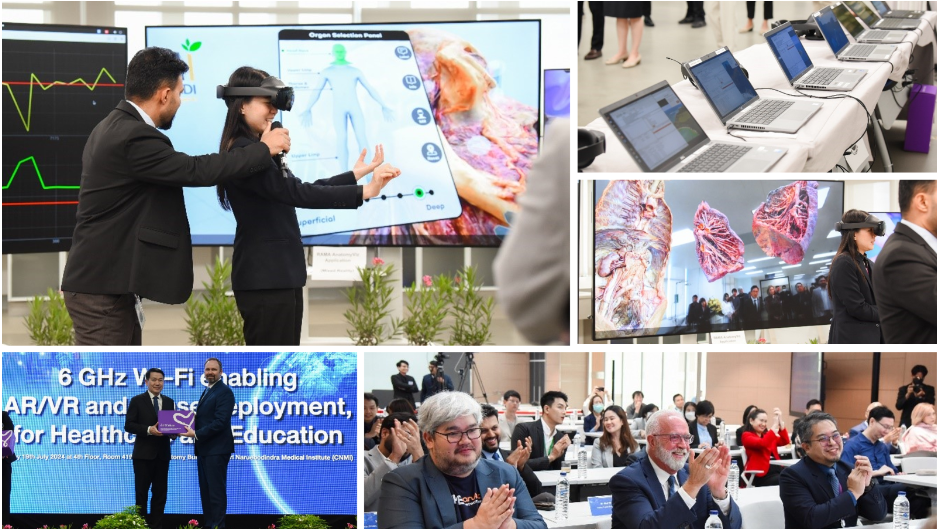Wi-Fi Alliance® and Ramathibodi Hospital, Mahidol University have been working together to promote the value of 6 GHz Wi-Fi®. In July, Ramathibodi Hospital and Wi-Fi Alliance, along with Wi-Fi Alliance member partners Hewlett Packard Enterprise, Intel, and Meta, successfully demonstrated how 6 GHz Wi-Fi will revolutionize the future of healthcare. The live demo showcased how utilization of the full 1200 MHz Wi-Fi in 6 GHz delivers the heightened throughputs and stringent latency needed for advanced augmented and virtual reality (AR/VR) applications that support medical education and training, efficiently serving dense environments such as classrooms and training seminars with hundreds of students and doctors.
Technologies used in this demonstration:
- Wi-Fi CERTIFIED 6® Routers with 6E capabilities: Aruba Multiservice Mobility Controller/AP-635 and 655 Access Points (AP)
- Wi-Fi CERTIFIED 7™ client devices: Intel® Wi-Fi 7 BE200
- Wi-Fi CERTIFIED 6 client devices: Intel® Wi-Fi 6E AX211 (Gig+)
- Meta Quest Pro Head Mounted Displays (HMD)
- Ramathibodi Hospital’s Anatomy Viz app
Demonstrated scenarios and outcomes:
The demonstration illustrated the difference in AR/VR performance and capacity levels when operating in the lower 500 MHz of 6 GHz compared to the full 1200 MHz available within the entire 6 GHz band. The demo showcased two sophisticated healthcare use cases that will support 200 medical students, doctors, and hospital faculty in Ramathibodi Hospital's classroom sessions:
- AR/VR technologies in medical training: AR/VR technologies like immersive virtual anatomy visualization allow for in-depth analysis of human anatomy, providing doctors and medical students with an immersive 3-D view of the human body including skeletal, muscular, neural, and soft tissue structures.
- Dense deployment streaming and file transfer: Next generation Wi-Fi allows every person in a 500-seat classroom to independently stream high definition video, transfer files, or utilize 5 GHz and 6 GHz multi-layer network segmentation and deployment, giving all students the opportunity to learn and collaborate uninterrupted, at the same time.
Scenario 1: Wi-Fi operation in the lower 500 MHz spectrum of 6 GHz
To simulate the current situation in Thailand, where only the lower 500 MHz of the 6 GHz band is available for unlicensed devices, the demonstration began with a baseline of Wi-Fi APs operating in only the lower 500 MHz band (network configuration: Wi-Fi 6E, a single 160 MHz channel in the 6 GHz band, co-channel Wi-Fi APs) with a single 160 MHz channel and minimal client devices (fewer than 10, including the Intel® Wi-Fi 7 BE200, the Intel® Wi-Fi 6E AX211 (Gig+), and Meta Quest Pro VR HMD). These devices used the network for ultra high definition video streaming, wireless casting of Ramathibodi Hospital’s Anatomy Viz app via a VR headset, and file transfers.
While the network performance and user experience were satisfactory with a small number of clients, it quickly deteriorated as more devices (up to 40 devices, including the Intel® Wi-Fi 7 BE200, the Intel® Wi-Fi 6E AX211 (Gig+), and Meta Quest Pro VR HMD) connected to the network using the above-mentioned applications. With only the lower 500 MHz of the 6 GHz band available, typical enterprise deployments like the Chakri Naruebodindra Medical Institute (CNMI) at Ramathibodi Hospital face inevitable channel repetition. This limited spectrum leads to co-channel and adjacent channel interference, significantly reducing network throughput and increasing latency by over 500%, with delays exceeding 200 milliseconds. This degradation resulted in frequent video buffering, glitches during streaming, and VR casting interruptions causing major lag that disrupted the immersive experience, making the interaction feel unresponsive and causing motion sickness for users during live seminars.
Scenario 2: Wi-Fi operation in the entire 1200 MHz spectrum in 6 GHz
The second scenario demonstrated the advantages of using the full 1200 MHz of the 6 GHz band. With the entire spectrum available, Wi-Fi APs could operate on 160 MHz channels spaced further apart spectrally, ensuring much-needed channel diversity (i.e., greater number of channels). The number of client devices and network load were identical to Scenario 1, and the configuration was tested by running the Anatomy Viz app on a VR headset and casting to a screen, along with streaming 8K videos, displaying hospital course material, and transferring files. In the absence of the adverse effects of co-channel interference (CCI) and adjacent-channel interference (ACI), data rate and latency measurements utilizing the entire 1200 MHz spectrum yielded very high data rates and significantly lower latency in the range of 20-30 milliseconds, delivering a smooth, glitch-free VR experience, as well as seamless ultra high definition video streaming, and high-speed file transfers without delays.
Degradation of performance with reduced spectrum availability
The demonstration confirmed the findings of previous theoretical studies, which emphasized that seven channels are necessary to achieve optimal performance in dense environments. As the demonstration illustrated, the use of 160 MHz channels is necessary to consistently deliver gigabit connectivity, as the Wi-Fi data throughout over 80 MHz channels only achieves gigabit data rates under specific propagation characteristics (i.e., very good RF propagation and/or very high number of parallel spatial streams). Using seven 160 MHz channels reduces interference between APs and ensures strong performance as user numbers grow, making them essential to dense environments such as universities, hospitals, and corporate offices.
Access to the full 6 GHz band is crucial
The demonstration underscored the importance of making the full 6 GHz spectrum available for Wi-Fi to deliver the stringent latency requirements and data throughputs needed for an optimal AR/VR user experience. “Wi-Fi Alliance is proud to showcase the immense potential of 6 GHz Wi-Fi to revolutionize healthcare,” said Kevin Robinson, President and CEO of Wi-Fi Alliance. “Today’s Wi-Fi technology offers unprecedented performance and reliability, and these demonstrations are just a glimpse of its potential to improve patient care and operational efficiency in healthcare settings.”
6 GHz Wi-Fi empowers future innovations
Wi-Fi in 6 GHz unlocks the full potential of advanced technologies, ensuring healthcare facilities are prepared to support future innovations and maintain the latest security practices to protect critical patient data. Making the full 6 GHz frequency band available for Wi-Fi not only supports emerging healthcare applications, but also provides the foundation for future advancements across market segments, including automotive, enterprise, home, IIoT, and more. The successful demonstration of 6 GHz Wi-Fi at Ramathibodi Hospital illustrates how cutting-edge Wi-Fi applications can strengthen medical training practices and serves as a model for nationwide adoption of the band in Thailand and around the world.

The statements and opinions by each Wi-Fi Alliance member and those providing comments are theirs alone, and do not reflect the opinions or views of Wi-Fi Alliance or any other member. Wi-Fi Alliance is not responsible for the accuracy of any of the information provided by any member in posting to or commenting on this blog. Concerns should be directed to info@wi-fi.org.




Add new comment